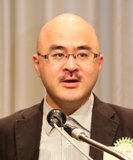ˇČStudies on CongestionˇÉ
March 17, 2010
Mr. Katsuhiro Nishinari
Professor, The University of Tokyo
 ˇˇI have been engaged in making scientific studies on the old proverb ˇČslow but steady wins the race.ˇÉ Highways during long weekends are hit by huge traffic jams, with people stuck in the queues.
ˇˇI have been engaged in making scientific studies on the old proverb ˇČslow but steady wins the race.ˇÉ Highways during long weekends are hit by huge traffic jams, with people stuck in the queues.
ˇˇCongestions at highways and general roads are triggered by different factors. Traffic light control and illegal parking are 2 main causes of congestion on general roads. Highways do not have either of these, so congestions are caused by different factors.
ˇˇAnimals are good at avoiding congestions. A huge school of 100 thousand sardines changes its direction in an instant. Likewise, a flock of migratory birds manages to fly longer distances by shifting their leader.
ˇˇVarious congestions take place within human bodies, causing illness. I currently study congestions of nerve cells that extend from the brain. The substances produced in the brain are delivered by proteins. When the proteins get jammed, it triggers neural diseases, such as forgetfulness.
ˇˇI founded the NPO ˇČMudatori (Eliminating Waste) AcademyˇÉand analyze the society from the perspective of congestion. Under the current economic situation, in spite of cost cutting efforts, there is large stock of goods, which is one form of congestion. Congestions also emerge during the production phase, which are called the bottleneck process. Without eliminating bottleneck process, the overall flow will be hampered and other top-of-the-line equipments are wasted, generating a chain of waste.
ˇˇˇČCongestion studiesˇÉ analyze wide-ranging phenomena of backups, including safe evacuation from earthquakes or fires and efficient logistical management.
ˇˇI made a correlation graph of traffic volume (number of cars passing a certain point in 5 minutes) and density (number of cars within 1-km scope at the same location), based on the data obtained from the Japan Highway Public Corporation. The analysis proved that congestion starts to emerge when the driving speed reaches 70km per hour, and there are ˇČabout 25-30 cars within 1 km stretch and only 40m between each car.ˇÉ
ˇˇ Congestions can be avoided by trying not to drive close up and keeping the distance. Smooth flow of people starts to get hampered when density exceeds the comfortable level of 1.8 people per 1Ö.
ˇˇLet me share with you what one of my students found after observing ants for 3 months in India. I think ants are cleverer than human beings, as they manage to keep the smooth flow by trying not to move closer to the ants in front.
ˇˇ They are smart enough to avoid inefficiency and work in harmony. Based on his findings, we wrote a thesis on how ants avoid congestion, which was published worldwide. Ants living today have survived the long history of nearly 400 million years because they know how to help each other and give way to others. We, the human beings with a history of only 4 million years, have something to learn from ants for survival.
ˇˇRecently, I have come to focus on the top-down and bottom-up approaches to manage and control over a million cars passing the Tokyo Metropolitan Expressway on a daily basis. The top-down approach tries to avoid congestion by controlling the flow of cars from external factors, such as raising the toll drastically. The bottom-up approach, on the other hand, aims at voluntary action taken by each driver. We worked on a challenging task to motivate each driver to act in harmony in a group, learning from the bottom-up behavior of ants or fish.
ˇˇWe conducted an experiment on how to remove congestion by just one car. We made 12 cars run in a line on a circuit racecourse. We made the front car stop for 5 seconds, assuming it was stuck in a traffic jam, before continuing. What happened? All the following 11 cars stopped once, as the distance closed up between the cars. We next made the same experiment under different condition, putting in the middle a car driving relatively slower with wider distance. Thanks to this distance from the car in front, the following 7 cars managed to run without stopping at all. We named this car in the middle the ˇČabsorbing carˇÉ as it literally absorbed the congestion.
ˇˇThis experiment proved that this absorbing car succeeded in removing congestion, while improving fuel and driving-time efficiency. We will all win by acting ˇČslow and steady.ˇÉ
ˇˇWe are actually making experiments by varying driving speeds at various locations. I am sure you all know Kobotoke Tunnel, an uphill road between Nagoya and Tokyo, notorious for the worst traffic jam in Japan. The congestion is caused as drivers tend to speed up at the downhill road just before the Tunnel, getting closer to the cars ahead. We succeeded in removing the traffic jam by driving at a slower speed of 70 km per hour.
ˇˇScientific studies have proved the importance of giving way and showing consideration to others. Before concluding my speech, I want you to keep in mind the phraseˇČ1 second for people, 2 seconds for cars.ˇÉ The best distance between people in a crowd is to step 1 second later on the footmark of the person in front of you. For cars, the theory proved that maximum traffic volume is secured by driving at a speed to keep 2-second-interval. ˇČYou will profit by showing consideration to others.ˇÉ This is the lesson I learnt from studies on congestion.